Picking up a guitar is exciting! You’re probably eager to start playing songs, but knowing where to begin can feel overwhelming. A fundamental starting point for any guitarist is learning chords. But what exactly are chords, and why are they so important? Guitar chords are the building blocks of harmony in music. They provide the rhythmic and harmonic foundation that makes music feel complete. While instruments like drums and bass focus on rhythm and depth, guitars, along with many others, excel at playing chords. Let’s dive into the world of Easy Guitar Chords for beginners, explore helpful tips and tricks, and discover songs you can start playing right away.
The School of Rock method emphasizes learning by doing, taking students from lessons to live performances. Whether you aspire to be a lead guitarist focusing on melodies and solos, or a rhythm guitarist laying down chords and strumming patterns, mastering chords is essential. And if you’re just starting out and need a guitar, our guitar-buying guide offers valuable advice for choosing your first instrument.
Understanding Basic Guitar Chords
Guitar chords might seem daunting initially, with different types and ways to play them. However, for beginners, focusing on the easiest types first is key to building a solid foundation and staying motivated. There are three main categories of chords, and we’ll explore the ones most friendly to new players.
Power Chords: The Rock and Roll Starting Point
Power chords are often among the first chords taught at School of Rock, and for good reason. They are incredibly common in rock, and also appear across many genres from classical to modern pop. The beauty of power chords for beginners lies in their simplicity. They typically involve just two or three strings and frets, making them physically easier to play and less demanding on your fingers.
While power chords work on any guitar, they are particularly impactful on electric guitars. When played on an electric guitar, they can be amplified and distorted to create a powerful, driving sound that defines rock music. This sonic versatility makes power chords not just easy to learn but also incredibly fun and rewarding to play, allowing beginners to quickly achieve a satisfying rock sound.
Open Chords: Your Gateway to Classic Songs
Open chords are another excellent type of easy guitar chord for beginners. What makes them “open” is that they incorporate open strings – strings that are strummed without being fretted by your left hand. Similar to power chords, open chords are generally easier to play because they involve fewer frets and fingers. However, unlike power chords which often use only a few strings, open chords typically utilize all six strings of the guitar, creating a fuller, richer sound.
The most common open chords are often referred to as the CAGED system, representing the chord shapes of C, A, G, E, and D. We’ll look at these essential chords shortly and explain how to play them. Open chords are fundamental for playing a vast repertoire of popular songs across genres, making them a must-learn for any aspiring guitarist.
Barre Chords: A Stepping Stone for Later
Barre chords are different from power and open chords and are generally considered more challenging for beginners. They involve using one finger to press down multiple strings across a single fret, acting as a “barre.” While they can be tricky at first, barre chords are incredibly versatile. Once mastered, you can move the entire chord shape up and down the guitar neck to create a wide range of chords without changing finger positions. This mobility makes chord transitions smoother once you get the hang of them.
However, the finger strength and dexterity required for barre chords make them less beginner-friendly compared to open and power chords. For now, we’ll focus on open and power chords as your starting point and tackle barre chords as you progress on your guitar journey.
Mastering Open Guitar Chords: CAGED and Beyond
Before diving into specific open guitar chords, it’s crucial to ensure your guitar is properly tuned. Playing in tune is essential for a pleasant sound and helps develop your ear. If you’re struggling with tuning, our guide on tuning a guitar for beginners provides helpful tips to get your guitar sounding its best.
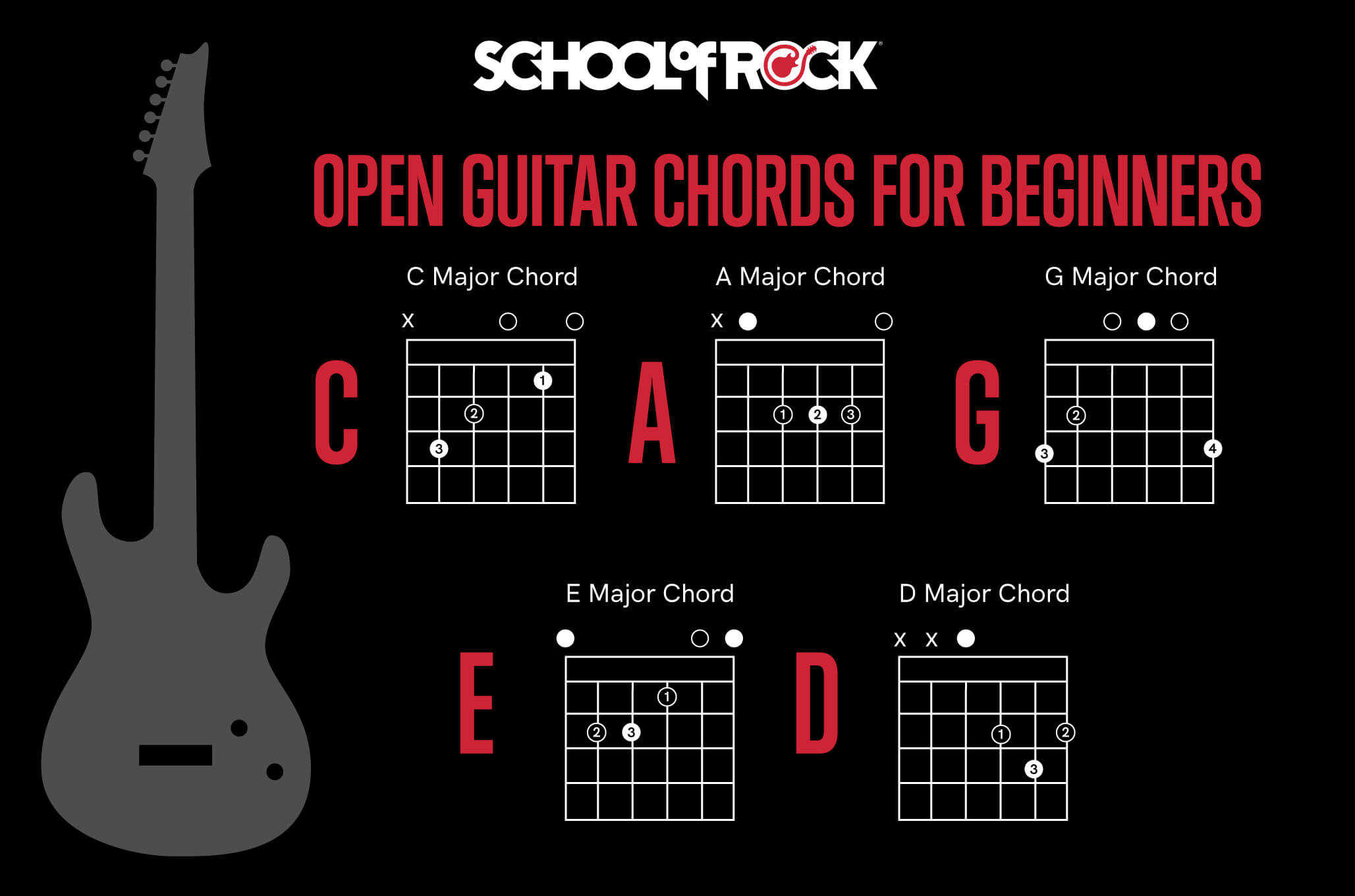 Diagram showing CAGED open guitar chords for beginners.
Diagram showing CAGED open guitar chords for beginners.
Let’s explore open chords, particularly the CAGED system, which is a cornerstone of the School of Rock’s performance-based teaching method. The majority of songs students learn and perform utilize these fundamental chords. CAGED is an acronym, with each letter representing a major open chord: C, A, G, E, and D. These chords are visualized using chord diagrams, which are essential tools for learning finger placements.
Understanding Chord Diagrams
A chord diagram is a visual representation of the guitar fretboard that shows you exactly where to place your fingers to play a chord. It’s read horizontally, with the leftmost line representing the thickest string (low E) and the rightmost line representing the thinnest string (high E). Imagine holding your guitar upright in front of you – that’s the perspective of the diagram.
Symbols on the diagram tell you what to do with each string:
- X: Indicates a muted string. This string should not be played.
- O (Circle): Indicates an open string. This string is played without any finger fretting it.
- Numbers (1, 2, 3, 4): Located on specific frets, these numbers indicate which finger to use: 1 = index finger, 2 = middle finger, 3 = ring finger, and 4 = pinky finger. The position of the number within the diagram indicates the fret and string. The first row of boxes represents the first fret, the second row the second fret, and so on.
For example, looking at the A Major chord diagram, you’ll see fingers indicated on the second fret. Specifically, your index finger goes on the second fret of the D string, your middle finger on the second fret of the G string, and your ring finger on the second fret of the B string. The diagram clearly shows you where to place each finger to form the chord correctly.
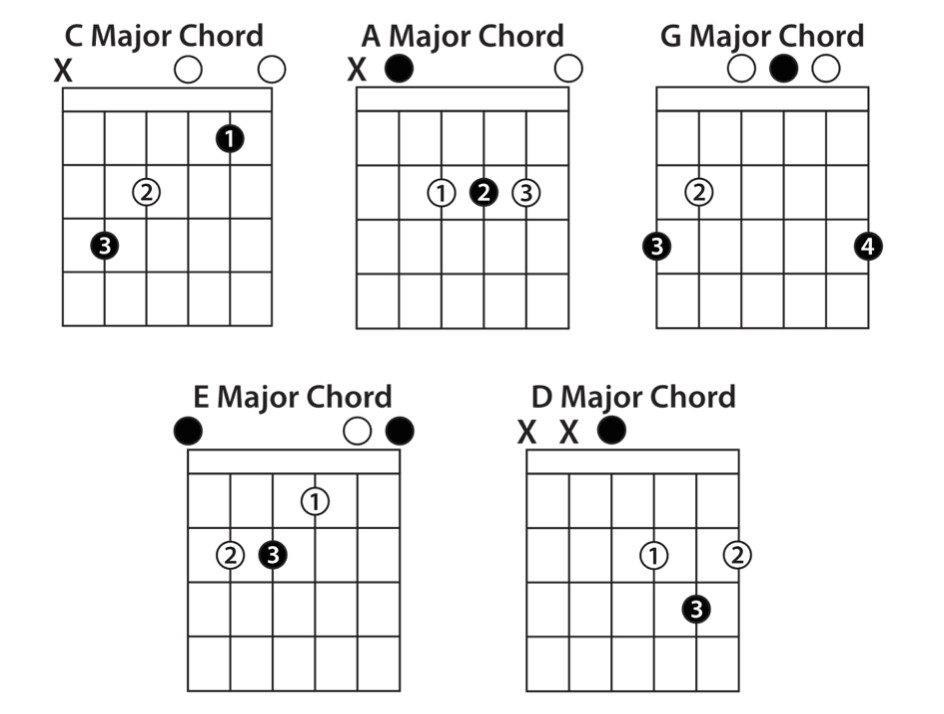 Diagram showing finger placements for A, C, D, E, G chords.
Diagram showing finger placements for A, C, D, E, G chords.
Beyond the CAGED chords, several other open chords are commonly used and are easy for beginners to learn. These include chords like Em (E minor), Am (A minor), and F major (while F barre chord is harder, a simplified open F version exists). Learning a selection of these fundamental open chords will unlock a vast library of songs for you to play.
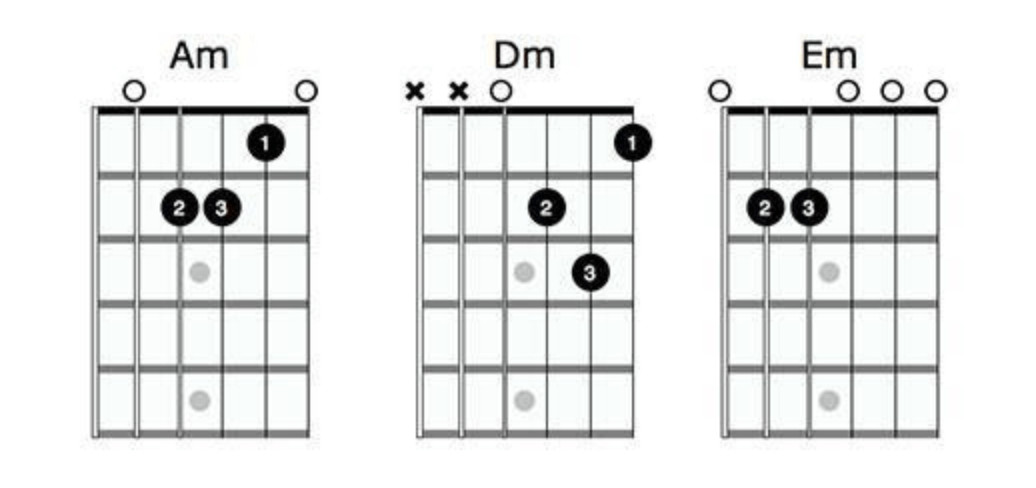 Diagram showing finger placements for Am, Dm, Em, and simplified F chords.
Diagram showing finger placements for Am, Dm, Em, and simplified F chords.
It’s important not to confuse chord diagrams with tablature (TAB). While both are visual aids for guitarists, they represent different information. Tablature is designed to show you which frets and strings to play to play a melody or riff. In tablature, the lines are read vertically, with the bottom line representing the low E string and the top line the high E string – the opposite of chord diagrams. Numbers on the lines in tablature indicate the fret to play on that string, with ‘0’ representing an open string.
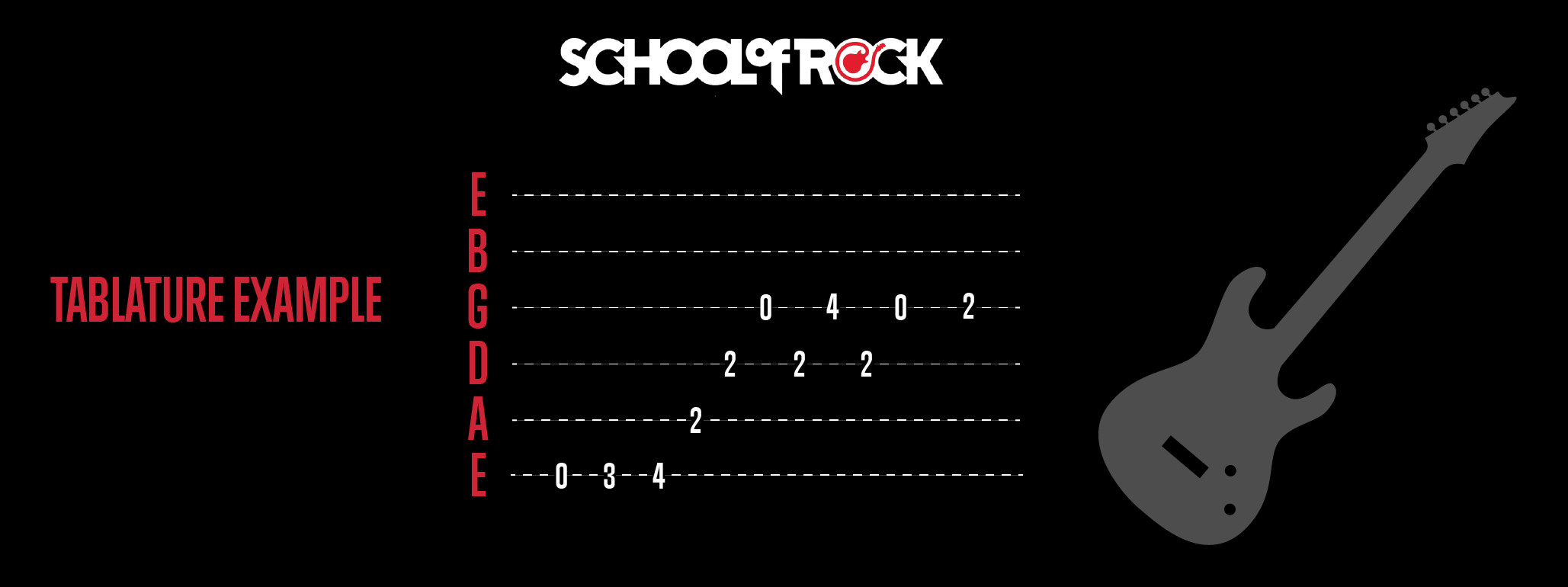 Example of guitar tablature.
Example of guitar tablature.
Chord diagrams are incredibly useful because they not only show you the finger placement for a chord but often suggest the most efficient fingerings for smooth transitions between chords. With consistent practice, these chord shapes and finger positions will become muscle memory, and you’ll be able to play them without constantly referring to diagrams.
To accelerate your learning and ensure you’re playing chords correctly, keep these tips in mind:
- Fret Close to the Fret Wire: On the guitar neck, metal bars called fret wires separate each fret. Position your fingers just behind these fret wires, closer to the bridge of the guitar. This requires less pressure to produce a clear sound. Experiment to find the sweet spot, usually in the middle of the fret space or slightly closer to the fret wire.
- Use Your Fingertips and Arch Your Fingers: Press down on the strings with your fingertips, not the pads of your fingers. Keep your fingers arched in a “C” shape. This ensures you apply pressure cleanly to the intended strings and avoid accidentally muting adjacent strings.
- Play Each String Individually: After forming a chord, strum each string separately to check for clarity. If a string sounds muffled or buzzy, adjust your finger position and pressure until each note rings out clearly. This helps identify and correct any mistakes in your finger placement.
- Practice Fretting and Unfretting: Practice transitioning into and out of chords smoothly. Lift your fingers off the fretboard and then quickly and accurately reposition them to form the chord again. You can even hover your fingers just above the frets in the chord shape to build muscle memory for the shape itself.
Songs to Play with Easy Guitar Chords
Now that you’ve learned some basic guitar chords, it’s time to put them into practice by playing songs! Many popular songs, especially classics, rely on simple chord progressions using open and power chords, making them perfect for beginner guitarists. Here are some songs that utilize the CAGED chords and basic minor chords:
- “Sweet Home Alabama” by Lynyrd Skynyrd: A classic rock anthem using only three chords: C, G, and D. A fantastic song to start with.
- “Bad Moon Rising” by Creedence Clearwater Revival: This upbeat track is in the key of D and uses G, D, and A chords. Another three-chord wonder!
- “Love Me Do” by The Beatles: A foundational Beatles tune in the key of G, using G, C, and D chords. Perfect for practicing chord changes.
- “Eleanor Rigby” by The Beatles: More melodic and in a minor key, this song uses C and variations of Em (E minor). Introduces minor chords into your repertoire.
- “Time of Your Life” by Green Day: In the key of G, this song uses G, C, Cadd9, and D5 power chords. You can simplify the D5 power chord to a regular D major chord and it will still sound great.
- “Island in the Sun” by Weezer: A catchy tune using Em, Am, D, and G chords throughout. The bridge section incorporates power chords, offering a chance to practice both open and power chords within one song.
- “Boulevard of Broken Dreams” by Green Day: In the key of Fm, this song uses Em, G, D, and A chords. Like “Island in the Sun,” it also features power chords towards the end, giving you more practice with both chord types.
More Popular Songs for Beginner Guitarists:
- “Hey There Delilah” by Plain White T’s
- “Hallelujah” by Leonard Cohen
- “Redemption Song” by Bob Marley
- “Smoke on the Water” by Deep Purple (main riff uses power chords)
- “Stairway to Heaven” by Led Zeppelin (intro uses fingerpicked chords)
- “Hotel California” by Eagles (intro uses fingerpicked chords)
Exploring Power Chords Further
Power chords are often considered easier than open guitar chords, but they share similarities with barre chords in terms of technique. Let’s understand the relationship between them. Compared to open chords, power chords are simpler in structure, using fewer notes, strings, and frets. However, the underlying chord shapes can be related.
Consider an A major chord and an A5 power chord. An A major chord contains the notes A, C#, and E. An A5 power chord contains just A and E. The A major chord includes the root, third, and fifth intervals, while the A5 power chord focuses on the root, fifth, and octave (which is the same note as the root, just higher). Essentially, the power chord is a simplified version of the major (or minor) chord, omitting the third.
This omission of the third is key: it makes power chords neither major nor minor. Because they lack a third, power chords can be used in place of either major or minor chords, depending on the musical context. Experiment with playing both open chords and power chords and listen for the sonic differences.
Power chords also offer a stepping stone to barre chords. “Three-string” power chords can be played using a barre-like technique, where one finger presses down two strings on the same fret. Practicing barring two strings for power chords helps develop the finger strength and technique needed for full barre chords later on.
Power chords are prevalent in classic rock and many genres of modern music. In School of Rock’s Rock 101 program, beginner guitarists often start with power chords to play rock songs. Here are some songs perfect for practicing power chords:
- “Wild Thing” by The Troggs: A garage rock classic heavily reliant on A5, D5, and E5 power chords, with occasional G5 power chords.
- “Let It Be” by The Beatles: Surprisingly versatile! You can play this iconic song using either open chords (C, G, Am, F) or power chords (C5, G5, A5, F5). Experiment with both!
- “Rock and Roll” by Led Zeppelin: The title says it all. This high-energy track uses A5, D5, and E5 power chords.
- “I Love Rock ‘n’ Roll” by Joan Jett: Another rock anthem driven by E5, A5, and B5 power chords.
- “When I Come Around” by Green Day: This entire song is built on power chords: F#5, C#5, D#5, and B5. A great workout for your power chord skills.
- “Rockin’ in the Free World” by Neil Young: Starts with power chords (E5, D5, C5) and then transitions into a mix of open and power chords (Em, D, C). A good example of how power and open chords can be combined.
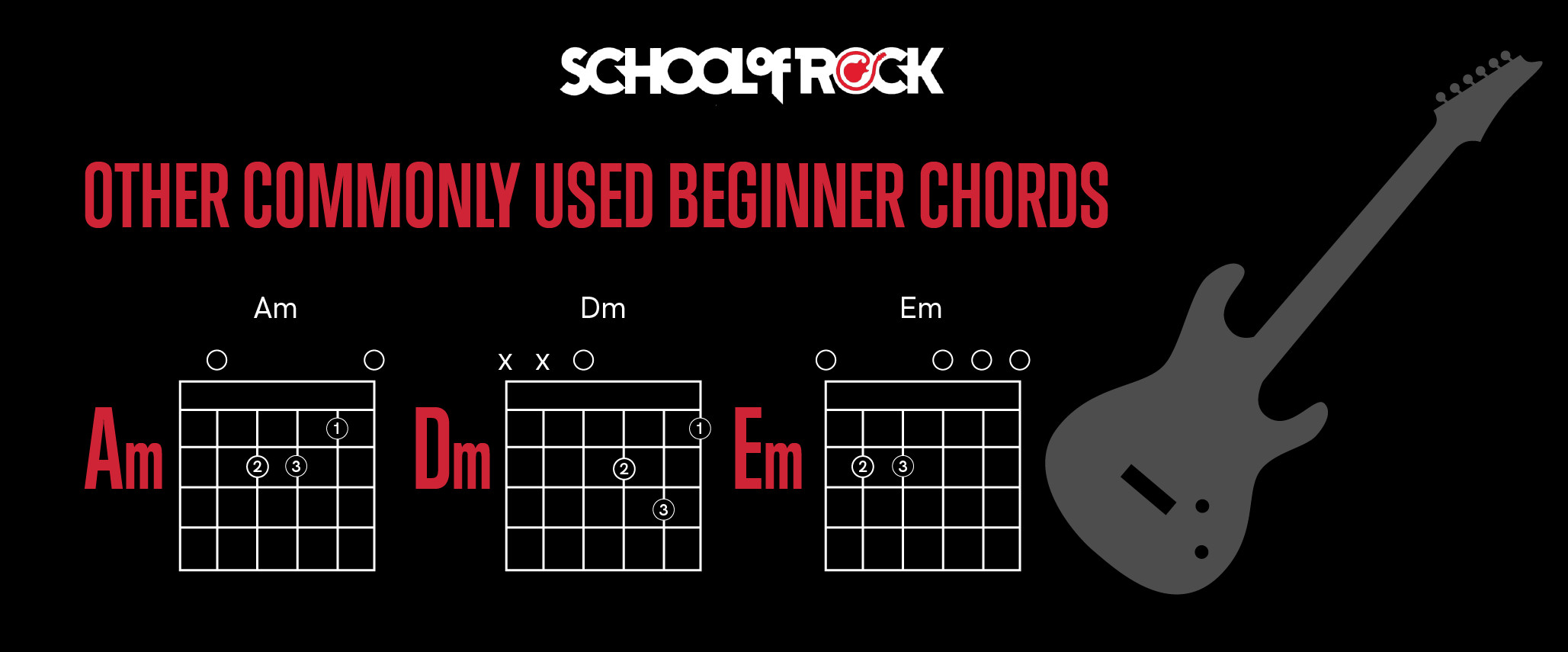 Diagram showing other commonly used beginner guitar chords like F, Bb, C7.
Diagram showing other commonly used beginner guitar chords like F, Bb, C7.
Take Your Guitar Playing Further
Now that you’ve explored easy guitar chords and songs to play, are you ready to take your guitar journey to the next level? Whether you want structured guidance or just need a little push, School of Rock is here to help. We offer private music lessons and diverse music programs designed to set you on the right path.
Programs like Rock 101 and the Performance Program are specifically designed to help beginner and intermediate players apply what they learn in private lessons to playing full songs in a band setting. Through these programs and lessons, students not only develop musical talent but also learn valuable life skills like teamwork and gain confidence through performance experience. Many of the songs mentioned in this article are part of the curriculum in these programs, teaching you open guitar chords, power chords, and fundamental music theory in a fun and engaging way. To learn more about how School of Rock can help you achieve your musical goals, contact the School of Rock location nearest you.
About the Author:
Miranda Morales is a dedicated guitar and keyboard instructor at School of Rock Easton in Pennsylvania, sharing her passion for music with aspiring musicians.
